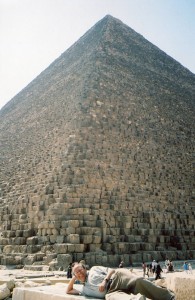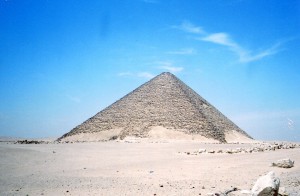In The Pyramid Posts; Why Did Ancient Egypt Build Pyramids? Part One, we began to see a rich web of ideas behind the pyramids.
Egyptians thought that creation came from the god Atum, beginning as a mound emerging from the primal ocean. But they blended the mound with other ideas of pyramids. These thoughts made up a rich web that was uniquely Egyptian.
1. Another key concept in Ancient Egypt was the horizon, where land and sky meet. Egyptians called it Akhet. This was the place where the dead were transformed into living inhabitants of the world of eternity.
2. Akhet was where the Pharaoh was reborn. His regeneration was tied to the order of the whole universe. This order was called Maat, and it ensured everything good: the Nile’s flooding, the growth of crops, social justice, human fertility, and beauty. The Pharaoh and Maat were fused. His rebirth ensured its continuity.
3. Egyptians had a unique concept of the soul. It had three components:
Ka is an energy, or vitality, and was associated with food sustenance. It’s hieroglyphic was two arms raising upwards. This image could have signified an embrace that transferred life-force between two people, or between gods and the king. It also could have meant the reception of energy from the sun. People offered food at tombs to feed it. When you have your lunch break, you’re nourishing your Ka.
Ba was written as a bird. This was a distinctive part of the person, whereas Ka was a more generic vitality. It was the part of the soul that would leave the body and fly around. The Bas of gods were imagined as stars and other objects. Shu’s Ba was wind. Even temple pylons, doors and sacred texts had Bas. The Ba still needed the body in the Afterlife.
Akh was splendor and radiance. This idea was also associated with the Pharaoh. His radiance rose to the sky, and he joined the family of gods. The Akh was a complete entity like the Ba, but it was glorified and associated with light. Mark Lehner wrote that the pyramid transformed the Pharaoh’s Ka and Ba into a glorious Akh that rose to the stars.
So the Pharaoh’s radiance was fused with the sky, the stars, the sun, the gods, and the order of the state.
This network of ideas was fused with the Akhet, the horizon where life was renewed–where the sun rose, and where the dead were reborn.
And all these ideas were seen in terms of the Nile’s flow, and its annual flooding, which gave life to the land.
Though pyramid is a Greek word, it’s important to see these monuments through Egyptian eyes. They weren’t just the abstract shapes the Euclid defined. They represented:
1. The energy from creation.
2. Transformation–the regeneration of life.
3. Forward motion–the Nile and the emergence of the sun and its path through the sky were main models of reality, and pyramids were seen in their terms–they empowered the soul to move through the gates of eternity.
4. The Pharaoh, and his central role in the continuity of the cosmic order.
5. Radiance–shining like the sun. The energy of life is golden, splendid, beautiful.
6. Eternity (djet)–worldly life was transformed into eternal life.
These ideas were fused into an optimistic view of the world that still captivates us 4,500 years later. Ancient Egyptians had more than 90 words for happy.
But there are still more treasures in this blend of ideas. We’ll discover them in the next and final post.



Comments on this entry are closed.